Indoor plants, also known as house plants, offer various benefits, including aesthetic appeal, visual interest, and indoor air purification. They exhibit many forms, ranging from lush, large-leaved jungle plants to little succulents resembling stones. An extensive selection makes a house plant suitable for every home gardener, catering to various light conditions and moisture preferences and thriving in humid bathroom environments.
Research has demonstrated that indoor plants contribute to enhanced mental well-being and improved air quality within the confines of a home. Certain house plants can absorb pollutants from household items such as fire-retardant furniture, further enhancing the atmosphere. Regardless of your level of expertise in tending to indoor plants, numerous options match your needs. Some indoor plants require minimal watering and infrequent repotting, making them exceptionally low-maintenance.
Tips for Growing House Plants
Cultivating house plants requires some understanding of their natural habitats, as most of them originate from tropical or desert regions accustomed to warmer, more humid, or drier environments than what we typically have in our gardens. Nevertheless, with a little care and attention, these plants can flourish within the confines of our homes. It’s important to note that different indoor plants have adapted to varying levels of rainfall, with some requiring minimal watering. In contrast, others need regular hydration to thrive.
Before purchasing a house plant, it’s crucial to assess the specific conditions for optimal growth and determine whether you can provide them in your home. Most indoor plants thrive in bright, indirect light, making a placement a few feet away from a window ideal. Avoid placing house plants near radiators, open fires, or air conditioning units, as these can adversely affect their well-being.
Explore more fast growing houseplant
How to Select House Plants?
When selecting indoor plants for your home, it’s essential to consider the conditions you can offer them. Purchasing sun-loving cacti would be futile if your space consists mainly of dark rooms and north-facing windows. Similarly, humidity-loving jungle plants are better suited for a bathroom environment.
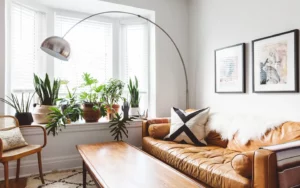
They may not thrive in other drier areas of the house. Conducting some research is highly recommended. If you develop an affinity for a particular plant, learn about its specific care requirements before bringing it home. This way, you can provide it with the optimal conditions for survival and ensure its best chance of thriving.
Indoor Plants
Still, we will provide you with a list of 30 popular houseplants in the United States and Britain, along with a brief explanation for each:
-
Spider Plant (Chlorophytum Comosum):
Known for their long, arching leaves with white stripes, spider plants are easy to care for and produce baby spider plantlets, making them a favorite choice for beginners. They thrive in a variety of light conditions and help purify indoor air.

-
Pothos (Epipremnum Aureum):
Pothos is a versatile trailing plant with heart-shaped leaves in various shades of green and variegated patterns. They are known for their durability and ability to tolerate low light conditions, making them ideal for indoor spaces with less natural light.

-
Snake Plant (Sansevieria):
Snake plants have long, upright leaves that come in different patterns and colors, such as green, variegated, or edged with yellow. They are hardy, low-maintenance plants that tolerate neglect and low-light conditions. Snake plants are also renowned for their air-purifying qualities.
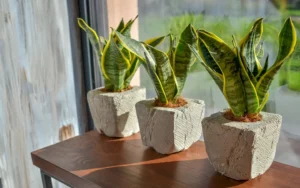
-
Peace Lily (Spathiphyllum):
The peace lily, popular for its ability to thrive in low-light environments, is recognized for its elegant white flowers and glossy green leaves. It’s an excellent air purifier and can help remove harmful toxins from indoor spaces, making it ideal for bedrooms or offices.
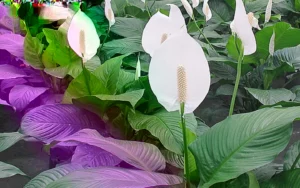
-
ZZ Plant (Zamioculcas Zamiifolia):
The ZZ plant features glossy, dark green leaves that grow in an attractive upright manner. It’s known for tolerating low light and irregular watering, making it a great choice for those who forget to water their plants. ZZ plants are also resilient and can survive in various indoor conditions.
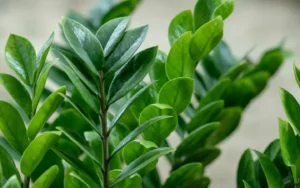
-
English Ivy (Hedera Helix):
English ivy is a versatile vine that can be grown as a hanging plant or trained to climb up walls or trellises. It has attractive, lobed leaves and can help purify indoor air by reducing airborne mold particles. English ivy requires moderate to bright indirect light.
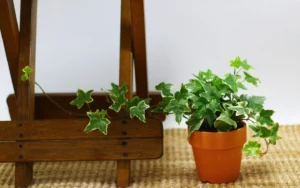
-
Rubber Plant (Ficus Elastica):
With its large, glossy leaves and tall, upright growth habit, the rubber plant adds a bold and dramatic touch to any room. It thrives in bright, indirect light and benefits from regular watering and occasional misting to maintain optimal moisture levels.
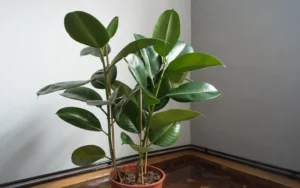
-
Boston Fern (Nephrolepis Exaltata):
Known for its lush, feathery fronds, the Boston Fern is a classic choice that adds a touch of elegance and freshness to indoor spaces. It prefers bright, indirect light and thrives in humid environments. Regular misting and watering are essential to keep its fronds healthy and prevent them from drying out.
-
Aloe Vera:
Aloe vera is a succulent with fleshy, pointed leaves that contain a soothing gel. It’s easy to grow and requires minimal maintenance. Aloe vera plants prefer bright, indirect light and well-draining soil. They are renowned for their medicinal properties, with the gel relieving minor burns and skin irritations.
-
Jade Plant (Crassula Ovata):
Jade plants are popular succulents with thick, fleshy leaves that store water. They are known for their resilience and adaptability, making them suitable for beginners and experienced plant enthusiasts. As drought-tolerant, Jade plants prefer bright, indirect light and infrequent watering. In folklore, they are believed to bring good luck and prosperity when placed in homes or offices.

-
African Violet (Saintpaulia):
African violets are lovely flowering plants that produce clusters of dainties, colorful blooms in shades of purple, pink, and white. They prefer bright, indirect light and slightly moist soil. African violets are perfect for adding color and elegance to tabletops or windowsills.
-
Philodendron (Philodendron spp.):
Philodendrons are beloved house plants with various species, each showcasing unique leaf shapes, sizes, and colors. They are relatively easy to care for and adapt to light conditions. Philodendrons are excellent for adding a touch of tropical foliage and greenery to indoor spaces.
-
Monstera Deliciosa:
Also known as the Swiss cheese plant, Monstera deliciosa features large, perforated leaves that add a tropical touch to any space. It thrives in bright, indirect light and moderate humidity. As it grows, it develops unique leaf fenestrations, making it a visually stunning addition to your home.
-
Dracaena Marginata:
Dracaena Marginata, also known as the dragon tree, is a popular choice for its slender, arching leaves in shades of green and red. It’s a relatively low-maintenance plant that can tolerate many light conditions. The dragon tree’s striking appearance adds a sculptural element to any room.
-
Areca Palm (Dypsis Lutescens):
Areca palms are graceful, feather-like plants that create a tropical ambiance indoors. They thrive in bright, indirect light and appreciate regular watering to maintain soil moisture. Areca palms are excellent for adding a touch of lush greenery and a sense of relaxation to living spaces.

-
Rubber Tree (Ficus Elastica):
Rubber trees are large, indoor trees with glossy, deep green leaves. They prefer bright, indirect light and regular watering. Rubber trees can grow tall over time, making them ideal as statement plants or for adding height to a room’s decor.
-
Yucca (Yucca spp.):
Yucca plants are characterized by their sword-shaped leaves and striking architectural presence. They can tolerate various light conditions, including bright, indirect, and even some direct sun. Yuccas are drought-tolerant plants that require well-draining soil.
-
Norfolk Island Pine (Araucaria heterophylla):
Norfolk Island pines have a distinctive pyramidal shape and resemble miniature Christmas trees. They prefer bright, indirect light and regular watering to moisten the soil. Norfolk Island pines add a festive touch and a unique structure to any indoor space.
-
Maidenhair Fern (Adiantum spp.):
Maidenhair ferns are delicate plants with lacy, fan-shaped fronds that create an airy and elegant look. They require moderate to bright indirect light and high humidity levels. Maidenhair ferns are best suited for bathrooms or rooms with a humidifier to replicate their preferred growing conditions.
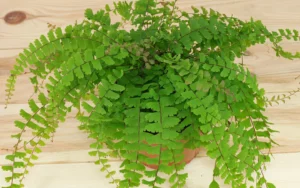
-
Croton (Codiaeum variegatum):
Crotons are tropical plants known for their vibrant, multicolored leaves in shades of red, orange, yellow, and green. They require bright, indirect light and high humidity. Crotons add a bold pop of color and a tropical vibe to any indoor space.
-
Chinese Evergreen (Aglaonema):
Chinese evergreens are attractive foliage plants with patterned leaves that come in various shades of green, silver, and red. They are adaptable to low light conditions and can thrive in areas with minimal natural light. Chinese evergreens are excellent choices for adding a touch of elegance to interior spaces.
-
Bird’s Nest Fern (Asplenium nidus):
Bird’s nest ferns feature wavy, apple-green fronds that unfurl from a central rosette, resembling a bird’s nest. They prefer bright, indirect light and high humidity levels. Bird’s nest ferns are popular for their unique texture and tropical aesthetic.
-
Swiss Cheese Vine (Monstera Adansonii):
The Swiss cheese vine is a trailing plant with leaves adorned with characteristic holes, similar to the Monstera deliciosa. It prefers bright, indirect light and slightly moist soil. Swiss cheese vines are great for hanging baskets or trailing down shelves, adding a touch of whimsy to your indoor garden.
-
Haworthia (Haworthia spp.):
Haworthias are small succulent plants with rosettes of thick, pointed leaves. They thrive in bright, indirect light and well-draining soil. Haworthias are compact and low-maintenance, making them perfect for small spaces or as part of a succulent arrangement.
-
Alocasia (Alocasia spp.):
Alocasias, also known as elephant ear plants, have large, showy leaves with intricate patterns and striking veins. They prefer bright, indirect light and high humidity. Alocasias are ideal for adding a touch of drama and tropical elegance to interior spaces.
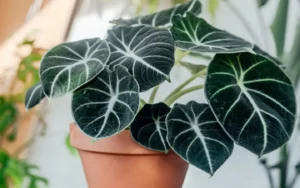
-
String of Pearls (Senecio Rowleyanus):
String of pearls is a trailing succulent with spherical, bead-like leaves. It thrives in bright, indirect light and well-draining soil. String of pearls is a unique plant that adds a touch of whimsy and charm when displayed in hanging baskets or trailing from shelves.
-
Parlor Palm (Chamaedorea elegans):
Parlor palms are compact and easy-to-grow plants with feathery, green foliage. They can tolerate low light conditions and prefer slightly moist soil. Parlor palms add a classic, tropical vibe to indoor spaces, making them a popular choice for home and office environments.
-
Bunny Ear Cactus (Opuntia Microdasys):
Bunny ear cacti are small, globular cacti covered in soft, harmless spines that resemble bunny ears. They prefer bright, indirect light and infrequent watering. Bunny ear cacti are visually interesting and easy to care for, making them a delightful addition to any cactus collection.
-
Golden Pothos (Epipremnum Aureum):
Golden Pothos is a popular trailing plant with heart-shaped leaves variegated in shades of green and yellow. It thrives in a variety of light conditions, including low light. Golden Pothos is an excellent choice for beginners or those looking to add a touch of vibrant foliage to their space.
-
Fiddle Leaf Fig (Ficus Lyrata):
Fiddle leaf figs have large, fiddle-shaped leaves that add a bold, sculptural element to interiors. They prefer bright, indirect light and regular watering. Fiddle leaf figs require some care and attention, but their striking appearance makes them highly sought-after as statement plants.
These 30 house plants represent a diverse range of species, each with its unique characteristics and care requirements. Consider factors such as lighting conditions, humidity levels, and your personal preferences when selecting plants for your home, and enjoy the beauty and benefits they bring to your indoor spaces.
KEYWORDS:
